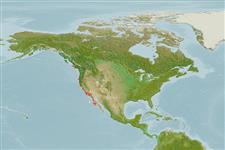>
Blenniiformes (Blennies) >
Clinidae (Clinids)
Etymology: metzi: Named after W.P. Gibbons, an early naturalist from Alameda, California and C.W. Metz, perceptive student of the genus Gibbonsia (Ref. 6885, 27436).
More on author: Hubbs.
Environment: milieu / climate zone / depth range / distribution range
Écologie
marin démersal; profondeur 0 - 9 m (Ref. 2850). Subtropical; 51°N - 27°N, 129°W - 114°W
Eastern Pacific: Vancouver Island, British Columbia, Canada to central Baja California, Mexico.
Taille / Poids / Âge
Maturity: Lm ? range ? - ? cm
Max length : 24.0 cm TL mâle / non sexé; (Ref. 2850)
Description synthétique
Morphologie | Morphométrie
Épines dorsales (Total): 34 - 37; Rayons mous dorsaux (Total): 7-10; Épines anales 2; Rayons mous anaux: 24 - 27; Vertèbres: 49. Caudal and pectorals rounded (Ref. 6885). Red or brown, weakly striped or mottled with darker shades (Ref. 6885).
Found among seaweeds, especially in tide pools and kelp.
Life cycle and mating behavior
Maturité | Reproduction | Frai | Œufs | Fécondité | Larves
Eschmeyer, W.N., E.S. Herald and H. Hammann, 1983. A field guide to Pacific coast fishes of North America. Boston (MA, USA): Houghton Mifflin Company. xii+336 p. (Ref. 2850)
Statut dans la liste rouge de l'IUCN (Ref. 130435)
Menace pour l'homme
Harmless
Utilisations par l'homme
Aquarium: Commercial
Plus d'informations
Taille/ÂgeCroissanceLongueur-poidsLongueur-longueurFréquences de longueursMorphométrieMorphologieLarvesDynamique des populations larvairesRecrutementAbondanceBRUVS
RéférencesAquacultureProfil d'aquacultureSouchesGénétiqueElectrophoresesHéritabilitéPathologiesTraitementNutrientsMass conversion
CollaborateursImagesStamps, Coins Misc.SonsCiguateraVitesseType de nageSurface branchialeOtolithesCerveauxVision
Outils
Articles particuliers
Télécharger en XML
Sources Internet
Estimates based on models
Preferred temperature (Ref.
123201): 10.7 - 19, mean 15.4 °C (based on 84 cells).
Phylogenetic diversity index (Ref.
82804): PD
50 = 0.6250 [Uniqueness, from 0.5 = low to 2.0 = high].
Bayesian length-weight: a=0.00513 (0.00223 - 0.01182), b=3.06 (2.86 - 3.26), in cm total length, based on LWR estimates for this (Sub)family-body shape (Ref.
93245).
Niveau trophique (Ref.
69278): 3.4 ±0.4 se; based on diet studies.
Résilience (Ref.
120179): Haut, temps minimum de doublement de population inférieur à 15 mois (Preliminary K or Fecundity.).
Fishing Vulnerability (Ref.
59153): Low vulnerability (14 of 100).
